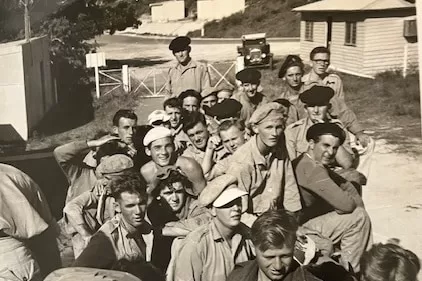It was a routine military training exercise that quickly took a turn for the worse.
In the early hours of March 8, 1954, a convoy of 20 amphibious vehicles — tanks that are viable on land and water — embarked on the 15th Northern Rivers Lancers annual camp.
Departing from Shortland Army camp, in the New South Wales city of Newcastle, the convoy was en route for a landing exercise 30 kilometres north at Morna Point.
But as it crossed the Stockton Bight the weather turned and heavy seas sunk eight vehicles and three men were killed.
Terry Sargent, a trained machine gunner, was among the survivors and said the tragedy was still fresh in his mind, 70 years on.
“It feels like it was last week; it’s something I’ll never forget,” Mr Sargent said.
“I know some fellas had nightmares over it.”
Convoy given the all-clear
Mr Sargent, who was 19 years old at the time, said the exercise began at 2am, with Colonel Jack James heading out past Nobby’s Headland to check if the waves were suitable for the tanks.
“He sent out the flare to say it was OK and we all went, one after the other,” he said.
“By the time we got out past Nobby’s Headland, the waves were huge, we could not turn.
“We were told the best thing we could do is keep going and go side on with the waves.”
The vehicle Mr Sargent was on sank before soldiers were picked up by the following tank, which was then flipped by a wave.
He recalled one soldier, Ron Gibbs, stripping down to his underwear and swimming to shore where he sought help.
“Everyone was frightened, there were definitely sharks in the water, we saw them and it was a notorious part of the ocean,” Mr Sargent said.
“The shark was nearly swimming alongside us.”
Mr Sargent also brought one of the tank’s drivers, Noel Moran, to shore.
He said Mr Moran had suffered head injuries and could not be revived when they reached land.
“I kept going in with others and pulling blokes out, they were seasick and very frightened,” Mr Sargent said.
Major Jack Wachsmann is a current commander of the 16th Combat Services Support Team.
He said there were reports of waves up to 6 metres hitting the tanks and it was local surf lifesavers who ultimately came to the rescue.
“It was in the dark, early hours and the Stockton Surf Lifesaving Club were roused out of their bed and ran straight into the surf to help,” Mr Wachsmann said.
Remembering 70 years on
A wreath-laying ceremony will be held at Shortland Park today to commemorate the 70th anniversary of what is now known as the Stockton Bight disaster.
Mr Sargent, who is now 89 years old, said he was not permitted to tell the true story of the event during a coroner’s court inquiry in the 1950s.
But he still holds fond memories of his time in the army.
“I was just proud to be in that regiment,” he said.
“I’m not dirty on anyone over this, I’m full of praise for a lot of them … It was just a big experience you’ll never forget.”
Get our local newsletter, delivered free each Wednesday
